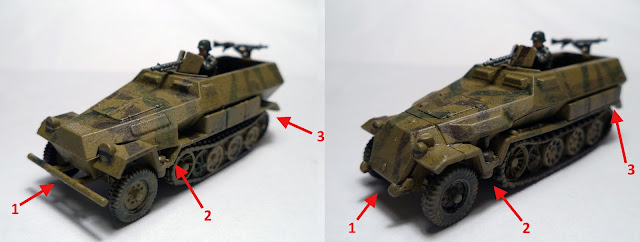From left to right; ausf A, ausf B, ausf C, ausf D.
The ausf A and ausf B are both converted from Zvezda's ausf A model (the box inaccurately calls it an ausf B), the hideous Zvezda machine guns being replaced with spares from the PSC sets. The ausf C and D are both straight out of the box PSC models. All are depicted in post 1942 style camouflage to make it easier to discern the differences between the models. The two earliest models had been out of production for some time before this camouflage was adopted.
Sd.kfz 251/1 ausf. A
The first variant of the 251. Prototyping for an 3 ton unarmoured halftrack had started in 1934, with the concept of using the same chassis as an armoured carrier added to the requirements a year later. It wasn't until June 1939, only two months before the Invasion of Poland, that they were first issued to units. This variant was only produced in small numbers and was discontinued in 1940.
Sd.kfz 251/1 ausf. B
The second variant of the 251. Little has changed from the first version, only minor evolutionary upgrades resulting from early feedback. The variant began production in 1939, only shortly after the ausf A, and was likewise discontinued in 1940.
Changes from ausf. a to ausf. b
1: The ausf B introduced a shield for the machine gunner, replacing the more flexible mounting. Many ausf A vehicles were upgraded to the ausf B's new mounting system.
2: The more important change was the removal of vision slots from the passenger compartments and the repositioning of vehicle tool sets to the mudguards.
Sd.kfz 251/1 ausf. C
The third variant shows the first structural modifications aimed at reducing production costs, and was also the first to see large scale production. It came into service in mid 1940 after the conquest of France, and continued in production until September 1943.
Changes from ausf. b to ausf. c
1: The first major noticed is the simplification of the front armour from two plate to a single plate
2: The cooling flaps were replaced with vent covers which allowed for better engine cooling
3: Another minor change was the repositioning of the storage lockers further to the rear.
Sd.kfz 251/1 ausf. D
The final variant began leaving factories in 1943 and was the simplest to build and most produced. The total production of all earlier ausf.s combined was a bare 4,650 vehicles, compared to 10,602 ausf D's. While production technically ended with the fall of Germany, the Praga and Tatra factories of Czechoslovakia continued production of the vehicle until 1963. These were designated as the OT-810 and may have be retrofitted by WWII re-enactment groups .
Changes from ausf. c to ausf. d
1: A follow from the simplification of the front plate seen in the change between the ausf B and ausf C. The rear armour drops from 6 armour planes and a complex hinging system to a single flat plate.
2: The stowage boxes and mudguards merge into a single piece integral to the hull.
Please let me know of any inaccuracies in my guide, I am not an expert and am always hunting for more information. Much of my data has come from websites such as WWII Vehicles.com.
~Bob
















